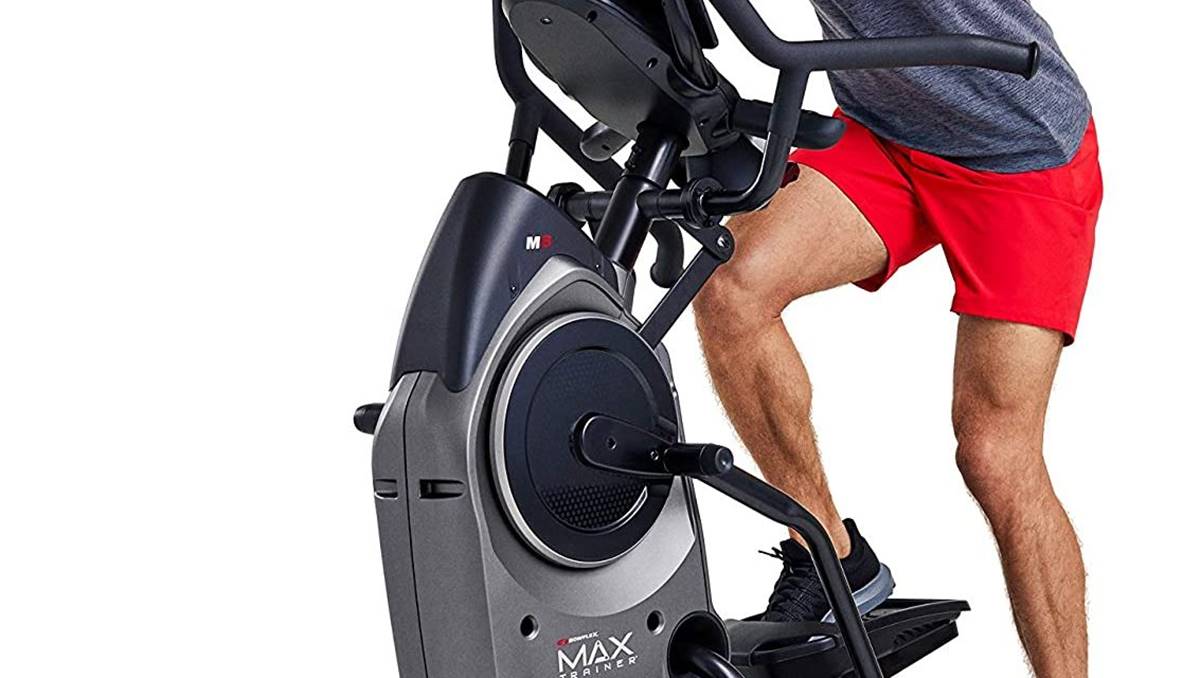Home>Misc>Featured>Which Of The Following Volumes Has The Greatest Potential To Increase Muscular Endurance


Featured
Which Of The Following Volumes Has The Greatest Potential To Increase Muscular Endurance
Modified: January 2, 2024
Find out which featured volume holds the greatest potential to enhance muscular endurance and make the most of your workouts.
Introduction
Muscular endurance is a crucial component of overall fitness and plays a vital role in various activities, from daily tasks to sports performance. It refers to the ability of muscles to exert force repeatedly or sustain a contraction over an extended period. Unlike muscular strength, which focuses on one-time maximum force, muscular endurance emphasizes the ability to perform repetitive movements or activities without fatigue.
Having good muscular endurance can enhance your overall physical capabilities and improve your performance in a wide range of activities, such as running, weightlifting, cycling, and even everyday tasks like climbing stairs or carrying groceries. It is particularly important for athletes who participate in sports or activities that require prolonged exertion, such as distance running, cycling, swimming, and endurance-based sports like soccer or basketball.
The endurance of your muscles is determined by various factors, including genetics, training methods, nutrition, and lifestyle choices. By understanding these factors and implementing the appropriate training techniques, you can maximize your muscular endurance and achieve your fitness goals.
In this article, we will explore different types of exercises or training volumes that have the greatest potential to increase muscular endurance. By incorporating these training methods into your fitness routine, you can optimize your muscular endurance and enhance your overall performance in various physical activities.
Definition of Muscular Endurance
Muscular endurance is a fitness component that refers to the ability of a muscle or group of muscles to sustain repeated contractions over an extended period without experiencing fatigue. It is a measure of how well a muscle can resist fatigue during continuous, repetitive activities. Muscular endurance is different from muscular strength, which focuses on the maximum force that a muscle can produce in a single effort.
Muscular endurance is commonly assessed through exercises that require the repetition of a specific movement or exercise for an extended duration, such as performing as many push-ups as possible or holding a plank position for a set time. These exercises challenge the muscles to maintain contractions over time without succumbing to fatigue.
To understand muscular endurance better, it is essential to recognize the difference between slow-twitch and fast-twitch muscle fibers. Slow-twitch fibers, also known as Type I muscle fibers, have a higher resistance to fatigue and are specialized for endurance activities. They generate energy aerobically, primarily through the use of oxygen. Fast-twitch fibers, or Type II muscle fibers, are more involved in activities that require short bursts of power and strength, but they fatigue more quickly.
Improving muscular endurance involves training and conditioning the slow-twitch muscle fibers to become more efficient and resilient. Through consistent and progressive training, the muscle fibers adapt by increasing their ability to generate ATP (adenosine triphosphate), improving oxygen utilization, enhancing energy efficiency, and delaying the onset of fatigue.
Having good muscular endurance provides various benefits, including the ability to sustain physical activities for longer durations, improved stamina, reduced risk of injury, and enhanced overall performance in sports and daily life activities. By incorporating specific training methods and exercises into your fitness routine, you can optimize and improve your muscular endurance levels.
Importance of Muscular Endurance for Fitness
Muscular endurance is a critical component of overall fitness and plays a significant role in enhancing performance and achieving fitness goals. Here are some reasons why muscular endurance is important:
- Enhanced Stamina: Muscular endurance training increases your body’s ability to perform continuous physical activities without experiencing excessive fatigue. By improving your stamina, you can engage in longer workouts, complete endurance-based activities, and maintain a higher level of energy throughout the day.
- Improved Performance: Muscular endurance is essential for athletes participating in sports or activities that require prolonged exertion. Whether you’re a distance runner, a swimmer, or a cyclist, having good muscular endurance enables you to sustain a high level of performance throughout the entire duration of your activity, giving you a competitive edge.
- Reduced Risk of Injury: Developing muscular endurance helps to stabilize your joints and maintain proper form during physical activities. This reduces the risk of injury, as fatigue can lead to compromised form and increased vulnerability to accidents. Training your muscles for endurance enhances their ability to withstand repetitive movements and reduces the strain on connective tissues.
- Increased Metabolic Efficiency: Muscular endurance training improves your body’s ability to efficiently use oxygen and energy. By working the slow-twitch muscle fibers, your muscles become more efficient at using fat as an energy source, resulting in increased metabolic efficiency. This can assist in weight management efforts and support overall cardiovascular health.
- Functional Fitness: Muscular endurance is not only beneficial for performance in sports but also for everyday activities. Tasks such as carrying groceries, climbing stairs, or even playing with children require the ability to sustain repetitive movements without fatigue. By improving your muscular endurance, you enhance your functional fitness, making daily tasks easier and more manageable.
It is important to incorporate exercises that specifically target muscular endurance in your fitness routine to reap the benefits mentioned above. By gradually increasing the volume and intensity of these exercises, you can develop and optimize your muscular endurance, enhancing your overall fitness and physical capabilities.
Factors Affecting Muscular Endurance
Several factors influence an individual’s muscular endurance capabilities. Understanding these factors can help you tailor your training and optimize your results. Here are some key factors that affect muscular endurance:
- Genetics: Genetics play a role in determining an individual’s muscle fiber composition, which can impact muscular endurance. Some people naturally have a higher proportion of slow-twitch muscle fibers, which are more resistant to fatigue and better suited for endurance activities. However, regardless of your genetic makeup, you can still improve and enhance your muscular endurance through training.
- Training Methods: The type of training you engage in significantly impacts your muscular endurance. Endurance-focused exercises, such as high-repetition sets, cardiovascular activities, and circuit training, all contribute to improving muscular endurance. By consistently incorporating these training methods into your fitness routine, you can train your muscles to withstand sustained contractions for longer periods.
- Nutrition and Hydration: Proper nutrition and hydration are vital for optimal muscular endurance. Consuming a balanced diet rich in carbohydrates, proteins, and fats ensures that your muscles have sufficient energy and nutrients to endure prolonged physical activities. Staying hydrated also supports muscle function and aids in the removal of metabolic waste during exercise.
- Rest and Recovery: Muscular endurance also relies on proper rest and recovery. Allowing adequate time for your muscles to repair and regenerate after intense workouts is crucial. Lack of rest can lead to overtraining, muscle fatigue, and a decline in performance. Incorporating rest days and engaging in activities that promote relaxation, such as stretching and foam rolling, can help maintain and improve muscular endurance levels.
- Progressive Overload: To improve muscular endurance, you need to subject your muscles to progressively increasing demands over time. This concept, known as progressive overload, involves gradually increasing the intensity, duration, or volume of your workouts. By challenging your muscles progressively, you stimulate their adaptation and improvement in endurance capabilities.
It’s important to note that these factors go hand in hand, and their influence on muscular endurance may vary from person to person. By understanding these factors and integrating strategies to address each one, you can effectively enhance your muscular endurance and achieve your fitness goals.
Volume 1: High-Intensity Interval Training (HIIT)
High-Intensity Interval Training (HIIT) is a training method that alternates short bursts of intense exercise with short periods of rest or lower-intensity exercise. This type of training is known for its efficiency and effectiveness in improving cardiovascular fitness and muscular endurance.
The high-intensity intervals in HIIT workouts typically range from 20 seconds to a few minutes, during which you perform exercises at maximum effort. These intense intervals are followed by short or active recovery periods, allowing your heart rate to come down before the next round of high-intensity exercise.
HIIT is an excellent volume to increase muscular endurance because it pushes your muscles to work hard and sustain repeated contractions over a short period. This trains your slow-twitch muscle fibers to become more efficient and resistant to fatigue.
The varied exercises in a HIIT workout engage multiple muscle groups, helping to improve overall muscular endurance throughout your body. Common HIIT exercises include burpees, mountain climbers, squat jumps, and high knees. These exercises often involve bodyweight movements and use minimal or no equipment, making HIIT accessible for all fitness levels.
In addition to improving muscular endurance, HIIT also offers several other benefits. It helps boost cardiovascular fitness, increases calorie burn, and stimulates the production of human growth hormone (HGH), which can aid in muscle growth and recovery.
When incorporating HIIT into your workout routine, it’s important to start at a level that is appropriate for your fitness level and gradually increase the intensity or duration as your endurance improves. It’s also essential to maintain proper form and technique during the high-intensity intervals to minimize the risk of injury.
A typical HIIT workout can be completed in as little as 20 minutes, making it a time-efficient option for improving muscular endurance. You can customize your HIIT routine by selecting exercises that target specific muscle groups or by incorporating equipment such as dumbbells, kettlebells, or resistance bands.
Remember, HIIT workouts are intense, and it’s important to listen to your body. If you are new to HIIT or have any underlying health concerns, it’s advised to consult with a healthcare professional or a certified fitness trainer before starting a new training program.
Volume 2: Circuit Training
Circuit training is a type of workout that combines cardiovascular exercises with strength training exercises in a series of stations or circuits. It is a highly effective training volume for improving muscular endurance.
During a circuit training session, you move from one exercise station to another, performing a set number of repetitions or a specific amount of time at each station. The exercises can target different muscle groups and can include bodyweight exercises, resistance exercises, and cardiovascular activities.
One of the key benefits of circuit training is that it provides a comprehensive full-body workout while also challenging your cardiovascular system. By constantly moving from one exercise to another with minimal rest periods, circuit training keeps your heart rate elevated throughout the session.
The combination of strength and cardiovascular exercises in circuit training helps to improve muscular endurance by subjecting the muscles to continuous work for an extended period. The combination of exercises and minimal rest between circuits keeps the muscles engaged and challenged, helping them adapt and become more resistant to fatigue.
Another advantage of circuit training is its versatility. You can design a circuit training routine to target specific muscle groups or focus on overall muscular endurance. You can also incorporate a variety of exercises and equipment, such as dumbbells, resistance bands, medicine balls, or bodyweight movements to add variety and progressive overload to your routine.
The intensity of circuit training can be modified to suit different fitness levels by adjusting the duration of each exercise, the number of repetitions, and the rest periods between circuits. As your muscular endurance improves, you can increase the number of circuits or increase the intensity to continue challenging your muscles.
It’s important to maintain proper form and technique during circuit training exercises to minimize the risk of injury. If you are new to circuit training or have any underlying health concerns, it’s advisable to consult with a healthcare professional or a certified fitness trainer before starting a circuit training program.
Circuit training offers a time-efficient option for improving muscular endurance, as it combines both strength and cardiovascular exercises into one workout. Incorporating circuit training into your fitness routine can help you develop overall endurance, boost your cardiovascular fitness, and enhance your muscular strength.
Volume 3: Resistance Training
Resistance training, also known as weight training or strength training, is a powerful volume for improving muscular endurance. It involves using external resistance, such as dumbbells, barbells, resistance bands, or machines, to challenge and strengthen your muscles.
Unlike traditional weightlifting, where the focus is on lifting heavy weights to build muscular strength, resistance training for muscular endurance involves using lighter weights and performing higher repetitions. This allows your muscles to work for longer durations without succumbing to fatigue.
Resistance training targets both slow-twitch and fast-twitch muscle fibers, contributing to enhanced muscular endurance throughout your body. By consistently challenging your muscles with resistance exercises, you can stimulate the adaptation and growth of slow-twitch muscle fibers, making them more efficient at sustaining contractions over time.
When designing a resistance training program for muscular endurance, it’s best to choose exercises that work multiple muscle groups simultaneously. Compound exercises like squats, lunges, bench presses, shoulder presses, and rows are ideal for enhancing overall muscular endurance.
Progressive overload is an essential concept in resistance training for muscular endurance. You gradually increase the intensity, duration, or volume of your workouts to continue challenging your muscles and promoting their adaptation. This can involve adding more weight, increasing the number of repetitions, or reducing the rest periods between sets.
As with any form of exercise, proper form and technique are crucial in resistance training. It’s important to learn the correct form for each exercise to ensure maximum effectiveness and reduce the risk of injury. If you’re new to resistance training, consider working with a certified personal trainer who can guide you through proper technique and provide guidance on appropriate exercises and weight progression.
It’s important to note that resistance training for muscular endurance is not limited to gym settings. You can also perform bodyweight exercises, such as push-ups, squats, lunges, and planks, which effectively challenge and improve muscular endurance. These exercises can be done anywhere and require little to no equipment.
By incorporating resistance training into your fitness routine, you can significantly improve your muscular endurance, increase strength, and enhance your overall physical performance. Whether you choose to use weights or rely on bodyweight exercises, resistance training offers a versatile and effective means of developing muscular endurance.
Volume 4: Endurance Running or Cycling
Endurance running and cycling are excellent volumes for improving both cardiovascular fitness and muscular endurance. These activities involve sustained, repetitive movements that challenge the muscles and cardiovascular system over an extended period.
Endurance running and cycling target the lower body muscles, including the quadriceps, hamstrings, calves, and glutes, while also engaging the cardiovascular system, improving lung capacity, and increasing overall endurance.
Running and cycling are highly adaptable exercises that can be modified to suit different fitness levels and goals. Whether you’re a beginner or an experienced athlete, you can adjust the intensity, duration, and distance to suit your individual needs.
When engaging in endurance running or cycling, it’s important to start at a level that is appropriate for your fitness level and gradually increase the intensity and duration over time. This allows your muscles and cardiovascular system to adapt and become more efficient in sustaining the repetitive movements for longer durations.
To enhance muscular endurance, it’s beneficial to incorporate interval training into your running or cycling routine. Interval training involves alternating between periods of high intensity and periods of lower intensity or recovery. This helps to challenge your muscles and cardiovascular system in different ways, improving both speed and endurance.
It’s important to listen to your body and practice proper techniques during endurance running or cycling to avoid injuries. Pay attention to your form, ensure you have proper footwear and equipment, and warm up and cool down adequately to prevent muscle strains or other related injuries.
Remember, endurance running and cycling can be outdoor activities, providing the added benefit of fresh air and the opportunity to explore new routes. However, if outdoor options are limited, you can still engage in these activities using treadmills or stationary bikes in the comfort of your home or a fitness facility.
By incorporating endurance running or cycling into your fitness routine, you can significantly improve your muscular endurance, increase cardiovascular fitness, and enjoy the mental and physical benefits of these activities. With consistency and progressive overload, you can achieve your endurance goals and continue to challenge and strengthen your muscles.
Volume 5: Plyometric Exercises
Plyometric exercises, also known as jump training or plyos, are a highly effective volume for improving muscular endurance and power. These explosive exercises involve quick, powerful movements that engage the muscles in a rapid stretch and contraction sequence.
Plyometric exercises primarily target the fast-twitch muscle fibers, which are responsible for generating quick bursts of power. By incorporating plyometric exercises into your training routine, you can train these muscle fibers to become more efficient and develop greater endurance.
Some common plyometric exercises include box jumps, squat jumps, jump lunges, burpees, and clap push-ups. These exercises require you to exert maximum force in a short amount of time, stimulating the muscles to contract quickly and forcefully.
Plyometric training not only enhances muscular endurance but also improves muscular power, which is the ability to produce force quickly. This can be beneficial for activities that require explosive movements, such as sprinting, jumping, and certain sports like basketball or volleyball.
When performing plyometric exercises, it’s crucial to have proper technique and form to minimize the risk of injury. Plyometric exercises involve high-impact movements, so it’s important to start with low-intensity variations and gradually progress as your muscles adapt and become stronger.
When designing a plyometric training session, it’s essential to incorporate rest periods between sets and exercises to allow your muscles to recover and avoid excessive fatigue. This allows your muscles to perform at their best during each explosive movement.
It’s important to note that plyometric exercises can be demanding on the joints and may not be suitable for everyone, particularly individuals with joint issues or injuries. It’s advisable to consult with a healthcare professional or a certified fitness trainer to determine if plyometric exercises are suitable for you based on your fitness level and any pre-existing conditions.
Incorporating plyometric exercises into your fitness routine can be a fun and dynamic way to improve muscular endurance and power. Remember to start gradually, focus on proper technique, and progressively increase the intensity and difficulty of the exercises as your endurance improves.
Conclusion
Improving muscular endurance is essential for enhancing overall fitness and performance in various physical activities. By incorporating specific training methods and volumes, you can enhance your ability to sustain repetitive contractions and overcome fatigue.
High-Intensity Interval Training (HIIT) is an effective volume that combines short bursts of intense exercise with periods of rest or lower intensity. It challenges your muscles and cardiovascular system, improving muscular endurance and overall fitness.
Circuit training, with its combination of strength and cardiovascular exercises, is another excellent volume to enhance muscular endurance. Moving through different exercise stations without much rest keeps your muscles engaged and challenged throughout the session.
Resistance training is vital not only for building strength but also for improving muscular endurance. By increasing the repetitions and using lighter weights, you can specifically target and improve the endurance capabilities of your muscles.
Endurance running or cycling offers a challenging yet effective way to improve both cardiovascular fitness and muscular endurance. By gradually increasing the duration and intensity of your workouts, you can enhance your endurance levels and boost your overall physical performance.
Plyometric exercises provide explosive and powerful movements that target fast-twitch muscle fibers. By incorporating plyometric exercises, you can improve both muscular endurance and power for activities that require quick bursts of energy.
Remember, when implementing these volumes, it’s important to gradually progress and listen to your body. Proper form, technique, and rest are crucial to prevent injuries and optimize your results. Consulting with a healthcare professional or certified fitness trainer can provide guidance tailored to your individual needs and goals.
Incorporating a variety of volumes into your fitness routine can help you achieve well-rounded muscular endurance and improve your overall fitness. By consistently challenging and training your muscles, you can optimize your endurance capabilities and experience enhanced performance in various physical activities.









